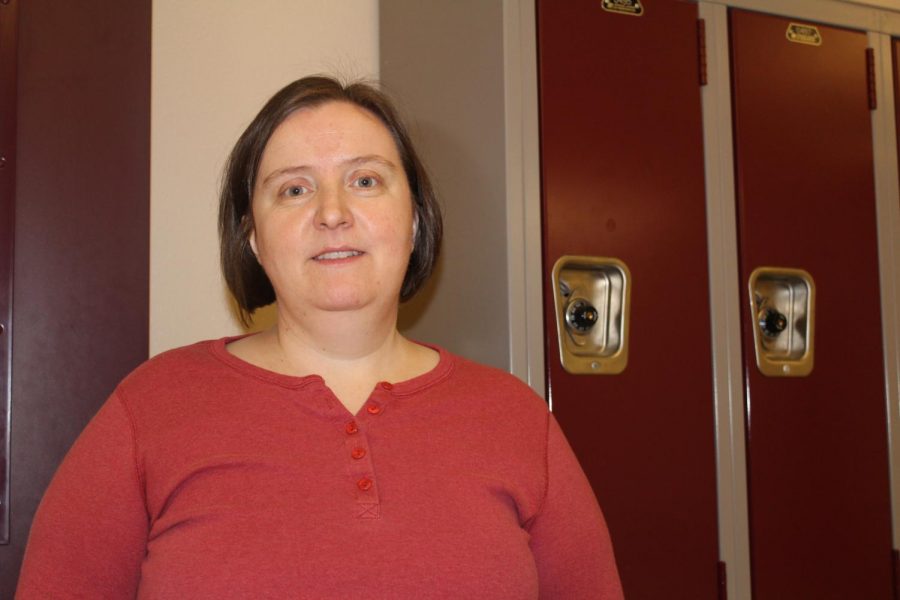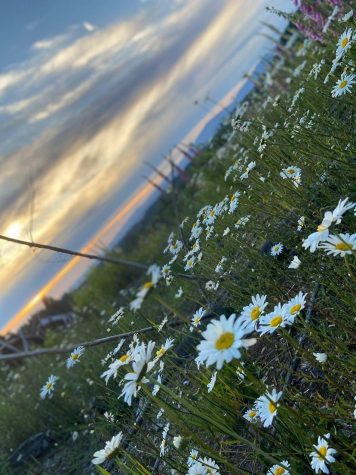Science Teacher Explains Classrooms’ Radon Levels
Piroska Balogh reflects outside of her classroom. Radon is a huge part of Balogh’s classroom.
My classroom is one of the ones that has higher levels of radon so I’ve been wondering about its source and finally got an answer from one of the radon abatement guys yesterday and the story is really cool. So, here’s your science lesson for the day!
Radon is a radioactive gas and is dangerous at higher levels since we breathe it in and if we have high exposure levels, we increase our risk of getting lung cancer. Radon is one of the radioactive decay products of uranium so to have radon problems, we need rocks under our building that contain uranium. But, our bedrock is all basalt, which doesn’t contain uranium, so how can we have radon?
It turns out that our radon producing rocks came from Montana during the Missoula floods. During the end of the last ice age 10,000 – 12, 000 years ago, there was a huge lake about the size of Lake Huron that formed behind an ice dam on the Clark Fork River on the border of Montana and the Idaho panhandle. The ice dam eventually failed, sending an immense flood through eastern Washington, down the Columbia river gorge up the Willamette to around Eugene and back out to the ocean along Highway 30 to Astoria. This happened about 40 times, every 50-60 years. Dramatic traces of this are found throughout the geology of Eastern Washington, in the Gorge, and down the Willamette Valley.
The flood waters carried icebergs covered in rocks from where the ice originally formed, in this case Montana. Wherever the icebergs melted, they left these rocks, called glacial erratics, behind. In this area, there are many baseball sized erratics buried throughout the soil brought here by these floods. These rocks formed in a different manner than our local basalt and contain uranium and thus emit radon gas. When they excavated the foundation for CHS, they pushed around these rocks and wherever they happened to pile up like under my room, we get higher radon levels.
Radon is a radioactive gas and is dangerous at higher levels since we breathe it in and if we have high exposure levels, we increase our risk of getting lung cancer. Radon is one of the radioactive decay products of uranium so to have radon problems, we need rocks under our building that contain uranium. But, our bedrock is all basalt, which doesn’t contain uranium, so how can we have radon?
It turns out that our radon producing rocks came from Montana during the Missoula floods. During the end of the last ice age 10,000 – 12, 000 years ago, there was a huge lake about the size of Lake Huron that formed behind an ice dam on the Clark Fork River on the border of Montana and the Idaho panhandle. The ice dam eventually failed, sending an immense flood through eastern Washington, down the Columbia river gorge up the Willamette to around Eugene and back out to the ocean along Highway 30 to Astoria. This happened about 40 times, every 50-60 years. Dramatic traces of this are found throughout the geology of Eastern Washington, in the Gorge, and down the Willamette Valley.
The flood waters carried icebergs covered in rocks from where the ice originally formed, in this case Montana. Wherever the icebergs melted, they left these rocks, called glacial erratics, behind. In this area, there are many baseball sized erratics buried throughout the soil brought here by these floods. These rocks formed in a different manner than our local basalt and contain uranium and thus emit radon gas. When they excavated the foundation for CHS, they pushed around these rocks and wherever they happened to pile up like under my room, we get higher radon levels.






